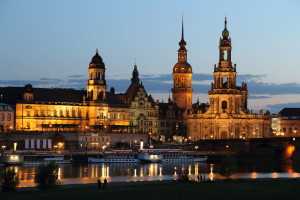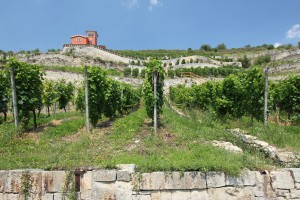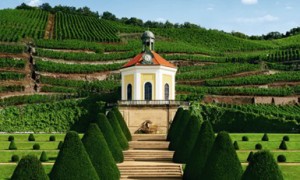Today we have a guest post from Lucia Volk, CSW. Lucia shares with us her interest in and discovery of the wines of Saxony!
If you have had your fill of Rieslings and Pinots from the Mosel, Rheingau, Rheinhessen and Pfalz – and find yourself in the mood for a different kind of German wine – let me draw your attention east, to the re-emerging wine region of Saxony!
Upstream and downstream from the city of Dresden, with its many baroque palaces, churches, cobble stone streets, and numerous museums, are about 1,100 acres of vineyards. These vineyards are part of the Sachsen region, which ranks 11th in size among Germany’s thirteen wine regions. The Elbe River and the hills along both sides helps create the weather and soil conditions that make wine growing possible at 51 degrees latitude. Officially, the wine region of Saxony stretches from Pillnitz in the south to Diesbar-‐Seußlitz in the north, along roughly 60 miles of Elbe, which then continues on to Hamburg and the North Sea.
Saxony’s glorious history involves a late 17th century duke-turned-king by the name of August the Strong, whose claim to fame (among many other things) is breaking horseshoes with his bare hands. He loved the good life (when he wasn’t going to war), and sponsored palaces with gardens, plazas and fountains; and filled museums with art. He hosted lavish parties and, of course, he needed wine. The historical record shows that within decades of his reign, 4,000 acres of vines were under cultivation by up to 8,000 wine makers – vastly more than Saxony’s current holdings.
The 1888 phylloxera infestation did much to reduce the vineyard acreage – two world wars, real estate development, and the state-planned economy of the German Democratic Republic did the rest. 1990, the year of Germany’s unification, is often considered as the starting point of Saxony’s wine revival. The eastern-most German wine region holds much promise with many young winemakers eager to catch up to the much more established wine regions in the southwest of Germany.
Wine producers along the Elbe currently come in three kinds: privately owned wineries, which include the prestigious – and Saxony’s oldest – Schloss Proschwitz as well as small innovators with 5-15 acres of each; the state-owned winery in historic Schloss Wackerbarth with nearly 250 acres and 100 employees; and the Wine Cooperative Meissen (Winzergenossenschaft Meissen) with 360 hectares and 1,500 participating part-time growers. The production volume varies accordingly, from 8,000 to 600,000 to one million bottles a year. Due to steep slopes and challenging growing conditions – late frosts in spring time, dry summers, and cold and wet harvest seasons – none of the producers above can expect a high yield, regardless of their vineyard locations or the grape varietals. If necessary (and feasible in terms of staffing) vineyards are harvested two or three times to give more grapes the opportunity to ripen fully.
Grapes grown in Saxony are mostly white (85%): Müller-Thurgau, Riesling, Pinot Blanc, Pinot Gris, and Traminer are the most widely planted; Bacchus, Muscat, and some Chardonnay are minor white grapes. Pinot Noir and Dornfelder lead the reds; Portugieser, Regent, and Schwarzrieslings can be found as well. A large part of the production is made into sparkling wine, following various production methods. Single-variety still wines come in the usual choices from dry to sweet, from Landwein to Trockenbeerenauslese. Cuvees are also offered, for instance, Traminer along with Riesling, or Pinot Noir plus some Portugieser. Premier vineyards are Seußlitzer Schlossweinberg, Proschwitzer Katzensprung und Radebeuler Goldener Wagen.
Schloss Proschwitz is Saxony’s oldest private winery, with its own castle and artistocratic owner Prinz von der Lippe. A renowned restaurant and upscale bed and breakfast invite guests to stay for a while. Still wines, sparklers, and liqueurs are on the shelves, each category in dazzling varieties, from a 13 Euro bottle of Müller Thurgau to a 58 Euro bottle of Pinot Noir. Many of its vineyards were originally owned by the church, most of the wine was made for mass. The church lost ownership over many of its estates to secular, liberal movements in Germany; later, the von der Lippe family lost its vineyards to state socialism, and only in 1990 did they begin to buy back what the family used to own. The winemaker hired to bring Schloss Proschwitz back to its old prominence was Geisenheim graduate Martin Schwarz, who recently started his own “wine manufacture,” as he calls it. In his able hands, Saxon grapes turned to refreshingly dry, aromatic, earthy wines. If you never had Müller-Thurgau you liked, you might find one here.
Erlebnisweingut Schloss Wackerbarth translates to “adventure vineyard” on Wackerbarth’s website. It is a winery that offers a full schedule of paired food, music, dance and theater events throughout the entire year, Christmas and New Year’s included. Guests can walk around expansive grounds with a historic palace and brand new restaurant, wine bar, cellar, and shop. With a seasonally adjusted staff of plus/minus 100, Schloss Wackerbarth bottles up to 600,000 bottles a year, the majority sparkling wine. On its premises, only traditional method, hand-riddled sparklers are made, a process visitors can witness from the tasting room overlooking the storage cellar facility. Another Geisenheim graduate, Jürgen Aumüller, took charge in 2002, dividing his attention between his cuvees (mostly for sparkling wine, but also for still) and single-variety wines. The state of Saxony owns the winery, and with the help of substantial investment of the Saxony Development Bank in the early 2000s; Schloss Wackerbarth now represents the new way of doing wine business on the Elbe river.
Founded in 1938 as Saxon Wine Cooperative (Sächsische Weinbaugenossenschaft), renamed the Wine Cooperative Meissen in 1955, and currently led by a woman winemaker, Natalie Weich, the cooperative produces half of Saxony’s wine, a million bottles per year on average. The vineyard holdings span the entire Elbe region, from Pillnitz to Diesbar-‐Seußlitz. You can find an interactive map (in German) on the cooperative’s website. Cooperative production historically allowed people to share production facilities and spread production risks. Grapes were an additional source of income, and under state socialism, an additional source of goods to trade. Grape quality was historically sacrificed to grape quantity, as producers were paid by weight they delivered. Those days are mostly days of the past, as producers realize that they need to compete with national and international standards. Wines from the cooperative regularly win gold, silver and bronze medals in the annual Federal German Wine Awards (DLG -‐-‐ Deutsche Landwirtschafts- Gesellschaft).
The natural beauty and regional history of the Elbe valley are already reasons for a visit. If you enjoy hiking and biking, you will be able to fill your vacation with memorable activities – but be sure and leave time to schedule wine tastings throughout. And you will want to leave space in your suitcases to bring some home!
Lucia Volk, CSW, is working on a manuscript on the lesser known wine regions of Germany. This summer, she discovered vineyards in Berlin, excellent Pinot Noirs along the Elbe and the Ahr, and phenomenal Riesling wines on the Mittelrhein.
Suggested further reading:
- Katherine Sacks, Deutsche Welle, October 2014: “Sample Eastern Germany’s Best Known Wine Region”
- Click here for a description of the Elbe wine trail for wine-‐loving hikers from the Sachsen Tourism Board





Thank you for a most informative article. Now I know where to go the next time I visit Germany: Erlebnisweingut, here I come!
Pingback: Guest Blog: Exploring Germany’s Mittelrhein - Wine, Wit, and Wisdom